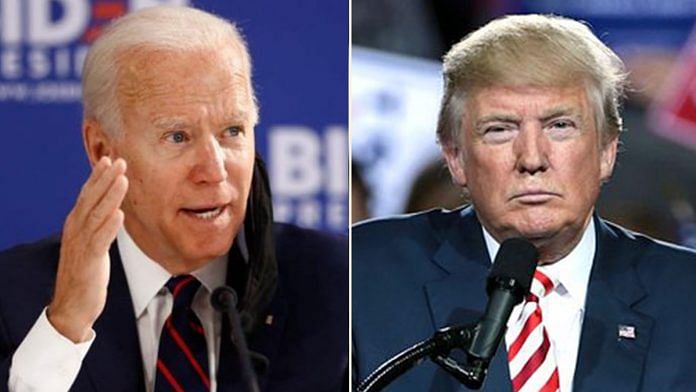New Delhi: The US elections have turned out to be a long-drawn and dramatic affair with the Democratic candidate Joe Biden nosing ahead of incumbent President Donald Trump now that the mail-in ballots are being counted.
In episode 611 of Cut The Clutter, ThePrint’s Editor-in-Chief Shekhar Gupta explained how this is possible and the many complicated peculiarities of the US electoral system.
At the beginning of the episode, Gupta highlighted the issue at stake, one which is being raised by Trump as well as his supporters: “The larger question is that how come…on the first day, it looks like of the votes counted immediately after the polling day i.e. November 3, Trump was ahead in most of the key states.”
The answer lies in the crucial mail-in ballots.
Ballots for Democrats?
Mail-in ballots are votes that are mailed, in case the voter is unable to make it to the centre for several reasons. Due to the ongoing pandemic, the number of mail-in ballots increased by nearly two-fold.
Gupta said that it is because of these mail-in ballots that Trump’s lead had come down in several of the key states, including Wisconsin, Michigan and Pennsylvania.
He then referred to an article by Nathaniel Rakich written in famous pollster Nate Silver’s website fivethirtyeight.com. The article specifically points to two polls — by NBC News and The Wall Street Journal. “And that poll tells you that first of all, this year, almost one-third of American voters — that is more than 30 per cent of American voters — had said they will vote by mail… Then 43 per cent said that they will go and vote physically,” Gupta said.
He highlighted the other important finding, which notes that 47 per cent of Biden voters had declared that they will vote by mail whereas only 11 per cent of Trump voters had said the same, with 66 per cent declaring that they will vote physically.
“This could be because Trump had said they will be a fraud in bailing ballots, because Trump had been saying that million ballots are not reliable, they will not reach on time,” Gupta noted. In fact, back in August, Trump had also opposed additional funding for the United States Postal Service to admittedly make it more difficult for them to deliver the ballots.
Overall Biden is projected to beat Trump by nine percentage points, Gupta said.
Also read: Trump or Biden, India-US ties will remain ‘strong and robust’ — Foreign Secy Shringla in UK
The electoral process
In order to explain the vastly complicated system of voting in America, Gupta pointed to another article written by Eric Bjornlund for the Foreign Policy magazine. Bjornlund had listed 10 “peculiarities” of the American elections.
According to the first point, unlike India, election day in the US is a working day. “That also gives you the incentive to mail in your votes earlier because it saves you the trouble of going and queuing up for voting that date … saves you the time,” Gupta said.
Furthermore, there is no uniformity in the electoral process across the different states in the country, with variations across “thousands of different jurisdictions”.
This boils down to the fact that the US “does not have a Central Elections Commission” as well as no common identification cards that can be a criteria for voter eligibility. “Because of all this, voter suppression is possible. Why is voter suppression possible? Because states can decide who will be not entitled to vote,” Gupta noted.
Adding to the complications is the fact that different states have different deadlines and requirements for the postal ballots.
Elucidating on some of these, Gupta said 40 states in America allow processing of mail-in ballots for absentee ballots before election day. Six states — including Wisconsin and Pennsylvania, which have kept us hanging for a long time — allow processing of absentee ballots only on election day. Seventeen states — including Arizona and Florida, which are also states in contention — start counting votes before election day.
Apart from this, some states accept mail-in ballots a few days after election day as long as they carry the voting day postmarks.
Watch the latest episode of CTC here:







Also interesting to note that casting a vote in US elections takes much more time as it is not making one or two selections. In addition to the candidates, voters also vote on 20 to 40 questions on various aspects that impact them (for example should the property tax be raised etc). These questions are decided at state level.